
by Scott C. France, University of Louisiana at Lafayette
May 3, 2018
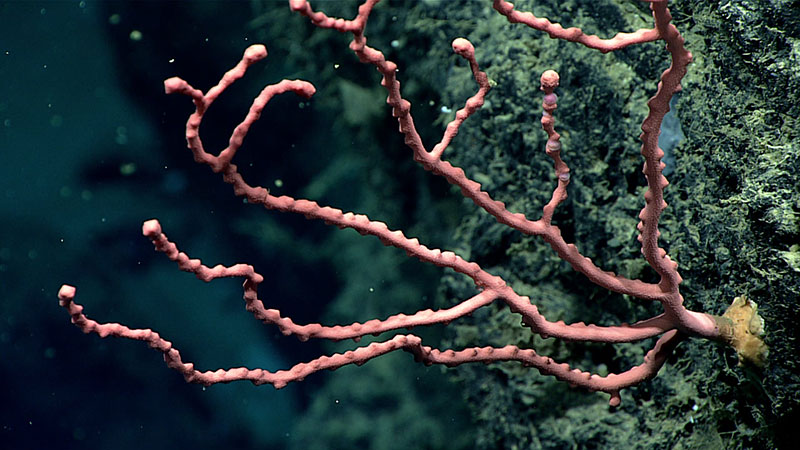
A bubblegum coral grows from the vertical face of a rock at 2,614 meters (~8,575 feet) depth in the De Soto Canyon region. At the base of the colony (on the right) the disc-shaped holdfast, which firmly attaches the colony to the seafloor, can be seen. It is not unusual for us to find holdfasts on the seafloor long after the rest of the colony has died. Image courtesy of the NOAA Office of Ocean Exploration and Research, Gulf of Mexico 2018. Download larger version (jpg, 1.1 MB).
Habitat is very important to all organisms, and deep-sea octocorals are no exception. The series of dives we have accomplished in the Gulf of Mexico have shown some stark contrasts in the animals we observe when traversing sediment-covered seafloor versus exposed hard substrates.
As members of the sessile fauna, octocorals live more-or-less attached and fixed in place in their habitat. As such, they need food to come to them. Accordingly, they have a variety of adaptations for capturing their food from the water column. In general, we can consider them as suspension feeders.
Sessile suspension feeders live on both soft sediments and rock. Among the octocorals, biodiversity is greatest where the seafloor is dominated by rock that has mostly been swept clear of sediment. Why is that? The exposed rock provides a clue that water flow in the area is strong enough to sweep settling sediment particles away, although in some situations it simply reveals there are so few particulates sinking to the seafloor that it takes a very long time for accumulation. If the water flow is strong, it means that more food is being moved horizontally per unit of time–in the water flow–past the octocoral, so there are more opportunities to feed than if the water was moving very slowly.
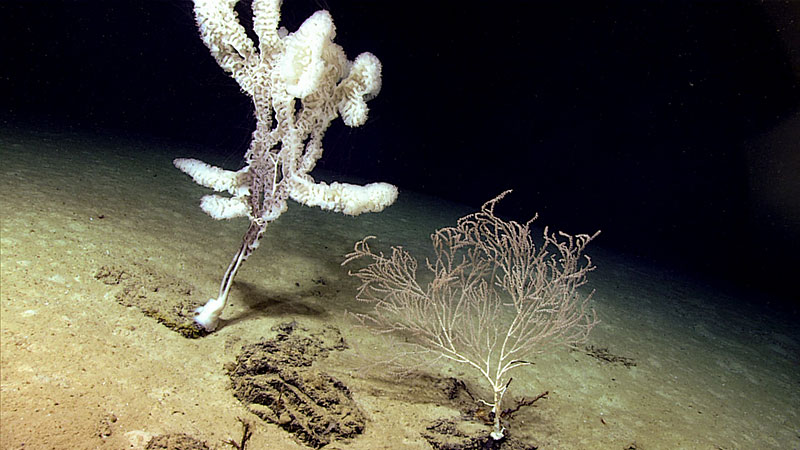
A bamboo coral (right), attached by its holdfast to hard substrate peeking out of sediments, was observed at 2,229 meters (~7,315 feet) depth at the southern end of the West Florida Escarpment. The glass sponge on the left is similarly attached to the exposed rock, but the surrounding soft sediments lack large suspension feeders, which need the firm surface to attach and grow to a large size. Image courtesy of the NOAA Office of Ocean Exploration and Research, Gulf of Mexico 2018. Download larger version (jpg, 1.3 MB).
The earliest life stage of an octocoral is a larva, essentially a small ball of ciliated cells that can move through the water or crawl over the substrate. This is the mobile stage of life by which octocorals can disperse to new areas. When they encounter an appropriate location, the larvae settle. A research question of much interest is how larvae determine the appropriate spot for settlement. This is a big decision, as the colony that develops will be essentially stuck to live its entire life, which could be decades to hundreds of years, in this spot.
On hard substrates, like rock, octocoral colonies secrete a disk-like holdfast that is secured to the substrate. This disk is an expanded base of the skeleton, and as the colony grows in size, the holdfast may also be enlarged to support the colony. The only way the colonies could change their position is if the rock to which they are attached comes loose and moves, perhaps downslope, or if part of the colony breaks and the fragment manages to get lodged such that reattachment is possible (essentially by producing a new holdfast). We have seen evidence of both of these processes during remotely operated vehicle Deep Discoverer (D2) dives.
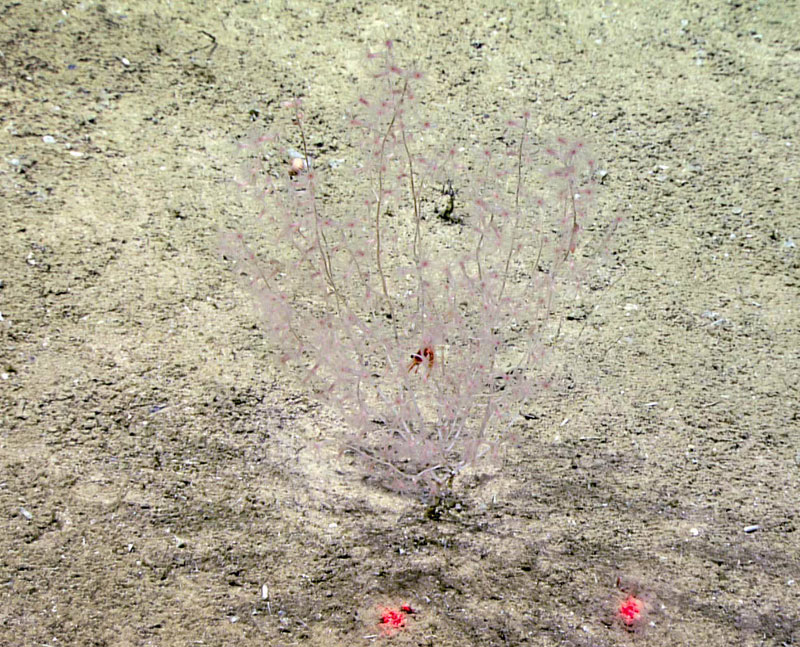
An Acanella bamboo coral rooted in soft sediments at 1,863 meters (6,112 feet) depth on the West Florida Escarpment. Image courtesy of the NOAA Office of Ocean Exploration and Research, Gulf of Mexico 2018. Download larger version (jpg, 1.2 MB).
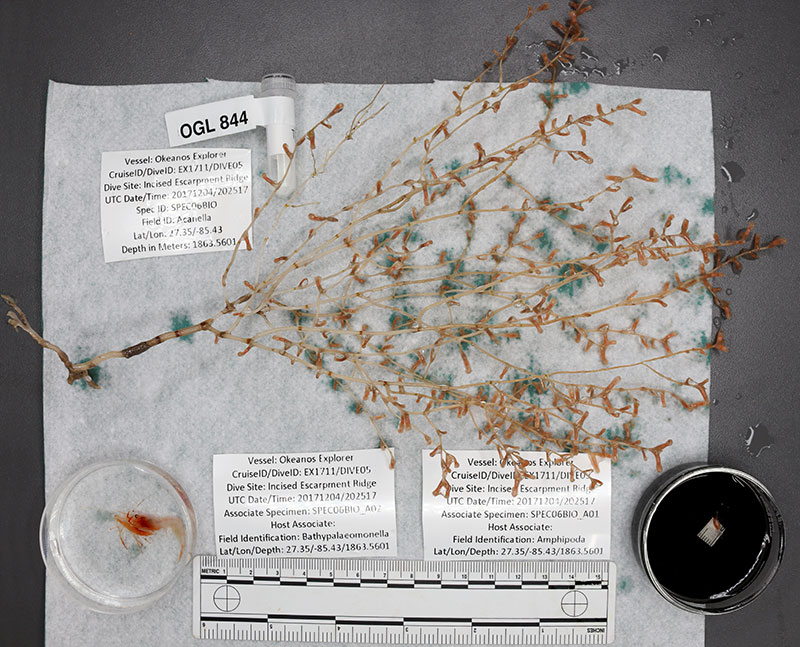
An Acanella bamboo coral collected from soft sediments reveals the base of the skeleton is modified as a rootlet (on far left). The rootlet allows the colony to be stable in the soft seafloor. Image courtesy of the NOAA Office of Ocean Exploration and Research, Gulf of Mexico 2018. Download larger version (jpg, 8.1 MB).
Some octocoral species are able to live in soft sediments and, in those species, colonies show two strategies. A few species, such as the bamboo corals Acanella arbuscula and Lepidisis caryophyllia, as well as the chrysogorgiid Radicipes gracilis, have evolved the ability to modify their calcareous holdfast into a root-like structure. An analogy for the formation of such rootlets at the base of the skeleton is hot wax at the base of a candle that runs in rivulets and hardens. Imagine the calcium carbonate “dripping” down into the sediment and hardening into roots. Acanella arbuscula can apparently live on either hard bottoms or soft sediments, and modifies the holdfast accordingly: a rootlet in the sediment and a disk-like holdfast on rock.
The major group of soft-sediment-dwelling octocorals is the sea pens (Pennatulacea). They have modified the base of the colony as a peduncle, a structure that can be inflated into a ball-like swelling for anchorage and stabilization. Interestingly in the last ten years, a discovery has been made of “rock pens,” sea pens that can live on a hard bottom. D2 has encountered many of these rock pens and they appear to use the peduncle like a suction-cup to hold their position on the rocky seafloor.
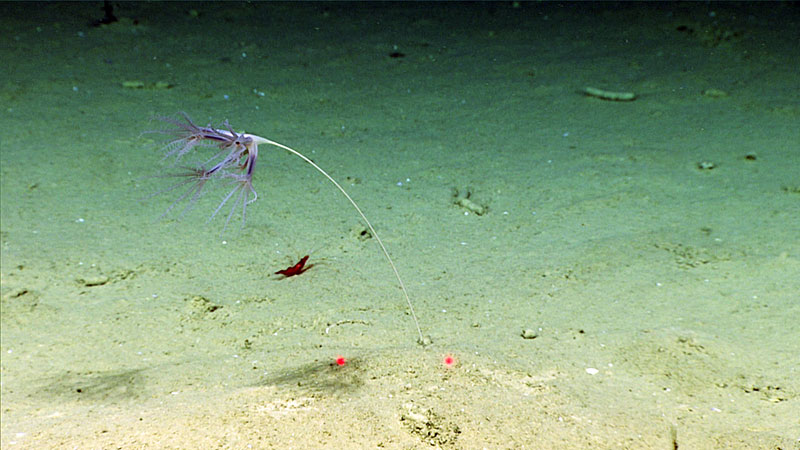
An Umbellula sea pen at 2,790 meters (~9,155 feet) depth in Perdido Canyon. Sea pens (Pennatulacea) are octocorals that are adapted to live anchored in soft sediments. At the base of the long, thin stalk is a swollen region, called the peduncle, that helps hold the colony in position. Image courtesy of the NOAA Office of Ocean Exploration and Research, Gulf of Mexico 2018. Download larger version (jpg, 1.6 MB).
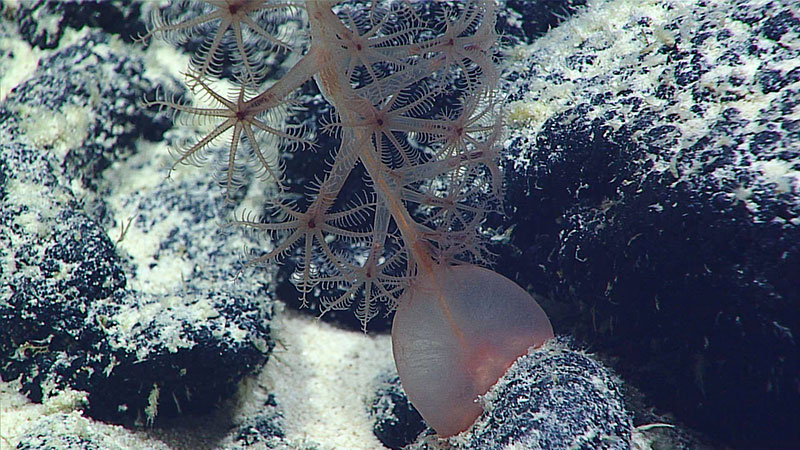
A relatively recent discovery is that some sea pens (Pennatulacea) live on hard bottoms. These “rock pens” use their peduncle like a suction cup, as shown on this colony at ~2,200 meters (~7,220 feet) depth on the North Manihiki Plateau. Image courtesy of the NOAA Office of Ocean Exploration and Research, Mountains in the Deep: Exploring the Central Pacific Basin. Download larger version (jpg, 1.8 MB).